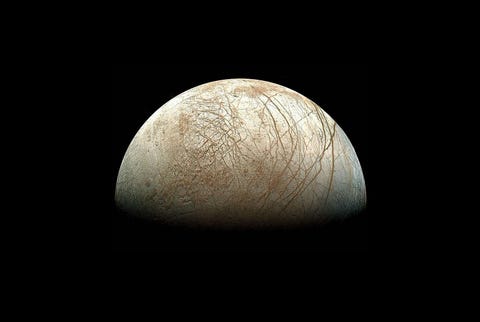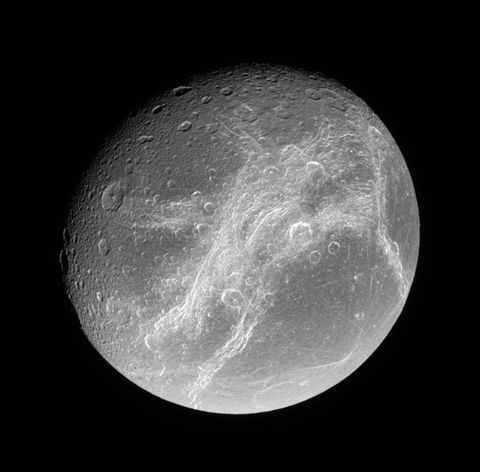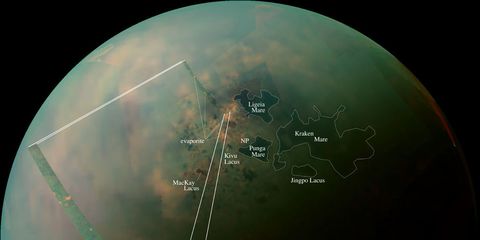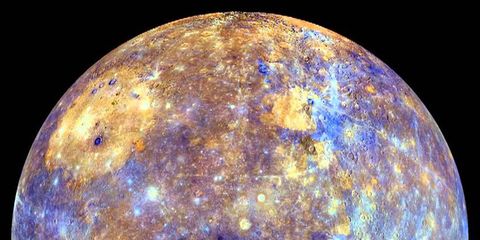"Perseverance" Rover (Mars - krater Jezero) : Novih 7 MINUTA TERORA
Page 9 of 28
Page 9 of 28 •  1 ... 6 ... 8, 9, 10 ... 18 ... 28
1 ... 6 ... 8, 9, 10 ... 18 ... 28 
 Re: "Perseverance" Rover (Mars - krater Jezero) : Novih 7 MINUTA TERORA
Re: "Perseverance" Rover (Mars - krater Jezero) : Novih 7 MINUTA TERORA
Sora wrote:
Američki znanstvenici uspjeli su razviti prvu sintetičku živu stanicu. Sintetička bakterija stvorena iz ničega dobila je nadimak Synthia
Nisu. Uspjeli su razviti nešto što imitira ponašanje žive stanice odnosno života samog, ali to efektivno nije.
Kužiš razliku?
Guest- Guest
 Re: "Perseverance" Rover (Mars - krater Jezero) : Novih 7 MINUTA TERORA
Re: "Perseverance" Rover (Mars - krater Jezero) : Novih 7 MINUTA TERORA
Speare Shaker wrote:Sora wrote:
Američki znanstvenici uspjeli su razviti prvu sintetičku živu stanicu. Sintetička bakterija stvorena iz ničega dobila je nadimak Synthia
Nisu. Uspjeli su razviti nešto što imitira ponašanje žive stanice odnosno života samog, ali to efektivno nije.
Kužiš razliku?
Je li ti poznata koncepcija imitacije života?

Guest- Guest
 Re: "Perseverance" Rover (Mars - krater Jezero) : Novih 7 MINUTA TERORA
Re: "Perseverance" Rover (Mars - krater Jezero) : Novih 7 MINUTA TERORA
Perverzno ruzan i pust okolis.Dobro,preskupi laboratorij je poslan milijunima kilometara daleko,da na Marsu,ne Zemlji,analizira "bilologiju" tla.Ne shvacam poantu toga,osim da se napumpaju troskovi ukupne operacije.Dotle,perspektivni Jupiterovi sateliti,sa metanom,vodom i sledjenom povrsinom povrh vode,nemaju nikakvu paznju "znanstvenika".Na Marsu se jalovo premecu kamencici,"divi se" okolini koja podsjeca na napustene kamenolome i nova odlagalista otpada.
Prasno prasnjavo i nezanimljivo..
Kolega Ero,reklo bi se da ste cisto populist i lobbist..Pogledajte 23 zanimljiva mjesta SA VODOM u solarnom sustavu.
Zanimljivije,poucnije,ljepse,perspektivnije..
https://www.popularmechanics.com/space/a14555/water-worlds-in-our-solar-system/
23 Places We've Found Water in Our Solar System
Oceans, Ices, Vapors: Turns out the Solar System isn't so parched. We survey the moons and planets where scientists are finding water in all its forms.

By John Wenz
Mar 16, 2015

NASA
[url=https://pinterest.com/pin/create/button/?url=https%3A%2F%2Fwww.popularmechanics.com%2Fspace%2Fa14555%2Fwater-worlds-in-our-solar-system%2F&description=23 Places We%27ve Found Water in Our Solar system&media=https%3A%2F%2Fhips.hearstapps.com%2Fpop.h-cdn.co%2Fassets%2F15%2F12%2F1426519431-europa.jpg%3Fresize%3D1600%3A%2A][/url]
Last week brought the news that Enceladus likely has a warm salty ocean, and that liquid water lurks beneath the surface of Ganymede. These findings are continuing to chip away at the once-held belief that the solar system was dry and barren, bereft of water.
It seems there are few places in the solar systems without some amount of water, whether liquid or solid. There's even a small amount of water vapor on Venus, something like 20 parts-per-million. And every time a source of liquid water is found or suggested, it brings up the chances of life on that world because of the way water acts as a solvent – facilitating the metabolic processes at the most basic level of life. That's why the hunt for extraterrestrial life (quite doubtfully of an intelligent sort, though we've found some quite remarkable octopuses on Earth) has turned from distant solar systems to our own cosmic backyard.
Here's the breakdown of all the water we know about in the solar system, and what form it comes in.
Europa has been the biggest contender for life for years now, with a craggy icy crust hinting in almost every way at an ocean below. Thanks to the tidal effects from Jupiter (friction inside the moon created by the pull of the planet's gravity), the water would be kept liquid and possibly even warm below the icy crust, helped by possible hydrothermal vents.
There's been some evidence of ice geysers shooting from the surface of Europa, as well as evidence that the ocean could have Hadley Cells—warm water radiating from the moon's equator. Europa could provide the possibility not just for life, but, if the conditions were just right, even complex life.
Enceladus

[url=https://pinterest.com/pin/create/button/?url=https%3A%2F%2Fwww.popularmechanics.com%2Fspace%2Fa14555%2Fwater-worlds-in-our-solar-system%2F&description=23 Places We%27ve Found Water in Our Solar system&media=https%3A%2F%2Fhips.hearstapps.com%2Fpop.h-cdn.co%2Fassets%2F15%2F12%2F1426519468-enc.jpg%3Fresize%3D1600%3A%2A][/url]
We've known of tiny, sleepy Enceladus since 1789. The diameter is just 310 miles, smaller even than Ceres and Vesta, the two largest objects in the asteroid belt. Compare that to Europa, slightly smaller than our Moon at a 1,950 mile diameter. Never mind its small size: This is one of the most intriguing places in the solar system and best candidates for a warm, wet, salty ocean. It has as high a probability for life, if not higher, than Europa.
Enceladus orbits near the rings of Saturn. In fact, watery eruptions from Enceladus' ice geysers comprise the F-Ring of the gas giant—the moon spews 1,000 tons of water into space every hour, according to Phil Plait at Bad Astronomy, along with organic molecules, salt, and other materials. Recent research suggests the ocean is also very warm thanks to the tidal effects from Saturn. The tug causes hydrothermal activity, which warms the oceans and causes the geysers, all in the kinds of hot beds that sprouted life on Earth.
Ganymede is the largest moon in our solar system, bigger than even the planet Mercury. Astronomers had long suspected that an ocean lies beneath the 100-mile-thick ice crust at the surface, and in a new study, aurorae activity suggest that the ocean is somewhat warm and definitely salty. Unlike Europa, no ice geyser activity has yet been spotted. This could be because of a reduced tidal effect on the moon, which is further from Jupiter than Europa. Unlike Europa, it doesn't have the cross-hatched icy surface showing consistent geologic surface activity. Still, the signs are good that Ganymede is harboring an ocean.
Callisto is similar in composition to Ganymede and, as the furthest out of the four Galilean moon of Jupiter, is bombarded with the least amount radiation. It also has a magnetic field, adding some additional protection.
We know there's water here—what we don't know is to what extent it's liquid. Callisto's relative lack of geologic activity suggests that the moon might not be able to sustain an ocean without the presence of some kind of anti-freeze compound within, meaning that there could be just a whole lot of ice in there. However, as the farthest out of the satellites, it could make an interesting destination for exploration, allowing you to avoid the harsher effects of Jupiter's radiation while remotely exploring the other moons for signs of oceans and life.
Ceres

[url=https://pinterest.com/pin/create/button/?url=https%3A%2F%2Fwww.popularmechanics.com%2Fspace%2Fa14555%2Fwater-worlds-in-our-solar-system%2F&description=23 Places We%27ve Found Water in Our Solar system&media=https%3A%2F%2Fhips.hearstapps.com%2Fpop.h-cdn.co%2Fassets%2F15%2F10%2F1425613647-pia19310a_lg.jpg%3Fresize%3D1600%3A%2A][/url]
NASA
Mars

[url=https://pinterest.com/pin/create/button/?url=https%3A%2F%2Fwww.popularmechanics.com%2Fspace%2Fa14555%2Fwater-worlds-in-our-solar-system%2F&description=23 Places We%27ve Found Water in Our Solar system&media=https%3A%2F%2Fhips.hearstapps.com%2Fpop.h-cdn.co%2Fassets%2F15%2F12%2F1426522123-mars-ocean.jpg%3Fresize%3D1600%3A%2A][/url]
NASA
The Red Planet probably once had oceans, including one covering a good chunk of the northern hemisphere. There are traces of water left on the surface, including compounds from the evaporation of the ancient ocean, as well as seasonal water ices covering the surface of the planet. There is some evidence pointing to occasional melting on the surface as well.
That much is clear. But there's an intriguing possibility that Mars still has water underneath the surface, possibly in the forms of aquifers. Theoretically, these underground waterways could still host microbial life under the surface of Mars. The question, then, is whether this water exists as ice or liquid, and how much of it lurks beneath the soil. An entire ocean's worth is unlikely, but a significant amount of subsurface water isn't.
Future missions, like the Mars 2020 rover and Russia's ExoMars probe, will look specifically for signs of organics and water under the martian surface.
Dione

[url=https://pinterest.com/pin/create/button/?url=https%3A%2F%2Fwww.popularmechanics.com%2Fspace%2Fa14555%2Fwater-worlds-in-our-solar-system%2F&description=23 Places We%27ve Found Water in Our Solar system&media=https%3A%2F%2Fhips.hearstapps.com%2Fpop.h-cdn.co%2Fassets%2F15%2F12%2F1426520319-dione-cassini-big.jpg%3Fresize%3D1600%3A%2A][/url]
The team behind NASA's Cassini probe, which has turned up many of the exciting findings about Saturn and its moon, joking called Dione a "weaker copycat of Enceladus." This Saturnian moon is much less active now than in the past, but it shows signs of geologic activity, including giant mountain peaks and other evidence pointing to a warmer history. It's possible that the moon retains enough of that heat for a small ocean to exists.
Pluto (and maybe Charon)
New Horizons will fly by Pluto this summer, becoming the first spacecraft to directly visit the world once known as the ninth planet. It may discover something that once seemed unlikely: an ocean.
Pluto is still seen mostly as an icy world. However, the tidal forces from its orbit with its largest moon Charon—combined with what scientists the violent formation of the system (a large collision likely formed Pluto and its five moons out of the same materials)—means Pluto could have hosted a ocean, and leaves open the outside possibility that it's still around.

It seems odd not to be able to include Titan, Saturn's largest and arguably most fascinating satellite, on this list. Titan has some of the most abundant pools of liquid found anywhere in the solar system, but those come in the form of methane, a hydrocarbon chain that's good for life, but not necessarily as we know it.
Still, Titan deserves to be mentioned in any tally of potentially habitable places because of its resemblance to early Earth. So here it is.

[url=https://pinterest.com/pin/create/button/?url=https%3A%2F%2Fwww.popularmechanics.com%2Fspace%2Fa14555%2Fwater-worlds-in-our-solar-system%2F&description=23 Places We%27ve Found Water in Our Solar system&media=https%3A%2F%2Fhips.hearstapps.com%2Fpop.h-cdn.co%2Fassets%2F15%2F12%2F1426520570-mimas.jpg%3Fresize%3D1600%3A%2A][/url]
Mimas, the "Death Star moon," is pretty much one big snowball. There doesn't seem to be much more to it than water ice. Yet a few unusual features hint at something weird on Mimas. The moon wobbles as it orbits Saturn, which indicates something unusual going on beneath the surface. The Cassini team says that it could be an ocean. But only maybe. The other chief possibility is that Mimas has a football-shaped core giving it the unusual tilt.
At around the size of Enceladus, the moon is too small to retain the heat from its formation, so any ocean on Mimas would have to have an outside force acting on it—possibly radioactive decay.
Triton

Triton as seen by Voyager 2
NASA
Neptune's largest moon, Triton, looks a lot like Pluto. There's a reason for that. Its retrograde (backwards) orbit in comparison to the rest of the system suggests that Triton could be a captured Kuiper Belt object, and not something that formed alongside the planet. The moon's surface seems to be a mix of methane and water ices, much like Pluto, and there's the outside chance of an internal ocean, provided there is enough heating or radioactive decay.
The moon likely has geysers, but instead of water they probably shoot nitrogen, giving the moon a thin atmosphere. We just don't know much else about Triton because the only close-up imaging came from Voyager 2's flyby in 1989.
Titania, Oberon, and Umbriel
The same thing goes for Uranian moons: We need a better look at them. But preliminary indications show that Titania and Oberon are likely ice and rocky materials. Neither has, at the time, enough evidence to support liquid water hypotheses without an anti-freeze agent like ammonia.
Umbriel, too, is largely composed of ice, but is even less likely to have an ocean. It does, however, contain a bright spot of ice near one of its poles, likely the effect of a crater impact on the surface. There is also evidence of carbon dioxide gasses trapped under the surface.
Tethys, Rhea, and Iapetus
These moons of Saturn appear similarly frozen, though there's an outside chance of liquid water on Rhea. These worlds are relatively inert, though Iapetus shows evidence of water sublimation (moving directly from solid to gas) on the surface. While these moons may not be good candidates for liquid water, they demonstrate the sheer abundance of water in the outer solar system.
The Kuiper Belt
There are hundreds of known objects out in the Kuiper Belt, where Pluto resides, many of them believed to be icy. The dwarf planets Eris and Haumea are believed to be similar to Pluto in composition, with water ice on the surface. But these small worlds have been discovered only in the last decade. There are also a few dwarf planet candidates that are known to be icy in nature, including Varuna, Quaoar, and Orcus. The latter has some indication of cryovolcanism and could potentially have a liquid ocean.
There are also a number of comets in the Kuiper Belt and beyond that are believed to be composed of water. This includes the first identified member of the Oort Cloud, Sedna.

NASA / MESSENGER
Perhaps the most surprising place water has been detected in the solar system is Mercury, the closest planet to the sun. While the surface is scorching, the pole are often untouched by the sun's heat, leading to an area where ice can accumulate. In October, the Mercury-observing MESSENGER spacecraft snapped some polar photos of the frozen ice caps. Liquid water is unlikely because Mercury is so hot, but MESSENGER found signs that some of the accumulations were recent.
The Moon
The Moon and Mercury, they're really not so different in appearance. Both are airless, rocky worlds, and both, it seems, have accumulations of water ice at the poles. Scientists had long suspected ice could be on the moon. India proved it in 2009… by crashing the Chandrayaan-1 probe headlong into the ice and seeing the plumes it formed.
While it's far from abundant, the water ice on the moon could help out moon colonization some day. If we ever get back there.
Neptune and Uranus
Here's another way that your grade school science textbook has been upended: Some researchers have begun calling Neptune and Uranus "ice giants" rather than "gas giants." In part, this is due to the abundance of ices in the lower layers of the planets, in weird states made possible by the intense pressure.
Still, it speaks to the abundance in our solar system, and the ways our views have changed from a dry solar system with a pale blue dot in its midst to one of abundant water and rife with possibilities for life.
Right now, Earth is the only true pale blue dot, the only place where life as we know it can exist, where temperature variables create a wide array of ecosystems and vegetation, where a thick, luscious atmosphere enables life by air, by sea, and by land. But it may not be the only genesis in our solar system. Life could thrive in dark depths of distant oceans, in forms large and small, life we can't fathom the shape of because it has no point of reference to any we've experienced. We also don't need to travel light years to find it.
It could provide way stations as we move out into the farther reaches of space. And if there's abundant water in our own backyard, it shows that it may not be so rare to find, and that we may not be alone in the universe, whether that's on a mini-Neptune 2000 light years away, or on a cold moon orbiting Saturn inside its rings
Prasno prasnjavo i nezanimljivo..
Kolega Ero,reklo bi se da ste cisto populist i lobbist..Pogledajte 23 zanimljiva mjesta SA VODOM u solarnom sustavu.
Zanimljivije,poucnije,ljepse,perspektivnije..
https://www.popularmechanics.com/space/a14555/water-worlds-in-our-solar-system/
23 Places We've Found Water in Our Solar System
Oceans, Ices, Vapors: Turns out the Solar System isn't so parched. We survey the moons and planets where scientists are finding water in all its forms.
By John Wenz
Mar 16, 2015

NASA
[url=https://pinterest.com/pin/create/button/?url=https%3A%2F%2Fwww.popularmechanics.com%2Fspace%2Fa14555%2Fwater-worlds-in-our-solar-system%2F&description=23 Places We%27ve Found Water in Our Solar system&media=https%3A%2F%2Fhips.hearstapps.com%2Fpop.h-cdn.co%2Fassets%2F15%2F12%2F1426519431-europa.jpg%3Fresize%3D1600%3A%2A][/url]
Last week brought the news that Enceladus likely has a warm salty ocean, and that liquid water lurks beneath the surface of Ganymede. These findings are continuing to chip away at the once-held belief that the solar system was dry and barren, bereft of water.
The hunt for extraterrestrial life has turned to our own cosmic backyard
More from Popular Mechanics
How Skis Are MadeIt seems there are few places in the solar systems without some amount of water, whether liquid or solid. There's even a small amount of water vapor on Venus, something like 20 parts-per-million. And every time a source of liquid water is found or suggested, it brings up the chances of life on that world because of the way water acts as a solvent – facilitating the metabolic processes at the most basic level of life. That's why the hunt for extraterrestrial life (quite doubtfully of an intelligent sort, though we've found some quite remarkable octopuses on Earth) has turned from distant solar systems to our own cosmic backyard.
Here's the breakdown of all the water we know about in the solar system, and what form it comes in.
Oceans
All But Confirmed:
EuropaEuropa has been the biggest contender for life for years now, with a craggy icy crust hinting in almost every way at an ocean below. Thanks to the tidal effects from Jupiter (friction inside the moon created by the pull of the planet's gravity), the water would be kept liquid and possibly even warm below the icy crust, helped by possible hydrothermal vents.
There's been some evidence of ice geysers shooting from the surface of Europa, as well as evidence that the ocean could have Hadley Cells—warm water radiating from the moon's equator. Europa could provide the possibility not just for life, but, if the conditions were just right, even complex life.
Enceladus

[url=https://pinterest.com/pin/create/button/?url=https%3A%2F%2Fwww.popularmechanics.com%2Fspace%2Fa14555%2Fwater-worlds-in-our-solar-system%2F&description=23 Places We%27ve Found Water in Our Solar system&media=https%3A%2F%2Fhips.hearstapps.com%2Fpop.h-cdn.co%2Fassets%2F15%2F12%2F1426519468-enc.jpg%3Fresize%3D1600%3A%2A][/url]
We've known of tiny, sleepy Enceladus since 1789. The diameter is just 310 miles, smaller even than Ceres and Vesta, the two largest objects in the asteroid belt. Compare that to Europa, slightly smaller than our Moon at a 1,950 mile diameter. Never mind its small size: This is one of the most intriguing places in the solar system and best candidates for a warm, wet, salty ocean. It has as high a probability for life, if not higher, than Europa.
Enceladus orbits near the rings of Saturn. In fact, watery eruptions from Enceladus' ice geysers comprise the F-Ring of the gas giant—the moon spews 1,000 tons of water into space every hour, according to Phil Plait at Bad Astronomy, along with organic molecules, salt, and other materials. Recent research suggests the ocean is also very warm thanks to the tidal effects from Saturn. The tug causes hydrothermal activity, which warms the oceans and causes the geysers, all in the kinds of hot beds that sprouted life on Earth.
The Probablies
GanymedeGanymede is the largest moon in our solar system, bigger than even the planet Mercury. Astronomers had long suspected that an ocean lies beneath the 100-mile-thick ice crust at the surface, and in a new study, aurorae activity suggest that the ocean is somewhat warm and definitely salty. Unlike Europa, no ice geyser activity has yet been spotted. This could be because of a reduced tidal effect on the moon, which is further from Jupiter than Europa. Unlike Europa, it doesn't have the cross-hatched icy surface showing consistent geologic surface activity. Still, the signs are good that Ganymede is harboring an ocean.
The Maybes
CallistoCallisto is similar in composition to Ganymede and, as the furthest out of the four Galilean moon of Jupiter, is bombarded with the least amount radiation. It also has a magnetic field, adding some additional protection.
We know there's water here—what we don't know is to what extent it's liquid. Callisto's relative lack of geologic activity suggests that the moon might not be able to sustain an ocean without the presence of some kind of anti-freeze compound within, meaning that there could be just a whole lot of ice in there. However, as the farthest out of the satellites, it could make an interesting destination for exploration, allowing you to avoid the harsher effects of Jupiter's radiation while remotely exploring the other moons for signs of oceans and life.
Ceres

[url=https://pinterest.com/pin/create/button/?url=https%3A%2F%2Fwww.popularmechanics.com%2Fspace%2Fa14555%2Fwater-worlds-in-our-solar-system%2F&description=23 Places We%27ve Found Water in Our Solar system&media=https%3A%2F%2Fhips.hearstapps.com%2Fpop.h-cdn.co%2Fassets%2F15%2F10%2F1425613647-pia19310a_lg.jpg%3Fresize%3D1600%3A%2A][/url]
NASA
Ceres has been known since 1801, but its small size has made it difficult to study. Until recently, it was believed to be a relatively rocky body. But recent observations from Hubble and evidence from the Dawn spacecraft, which just arrived there, have raised an intriguing possibility: that Ceres is less a ball of rock and more a watery dwarf planet with an icy mantle and a slushy ocean below. Located in the asteroid belt between Mars and Jupiter, the world could be our nearest oceanus neighbor. If it's true, it would be the nearest world to Earth with an ocean. We'll know more soon as Dawn's work continues.Ceres is less a ball of rock and more a watery dwarf planet
Mars

[url=https://pinterest.com/pin/create/button/?url=https%3A%2F%2Fwww.popularmechanics.com%2Fspace%2Fa14555%2Fwater-worlds-in-our-solar-system%2F&description=23 Places We%27ve Found Water in Our Solar system&media=https%3A%2F%2Fhips.hearstapps.com%2Fpop.h-cdn.co%2Fassets%2F15%2F12%2F1426522123-mars-ocean.jpg%3Fresize%3D1600%3A%2A][/url]
NASA
The Red Planet probably once had oceans, including one covering a good chunk of the northern hemisphere. There are traces of water left on the surface, including compounds from the evaporation of the ancient ocean, as well as seasonal water ices covering the surface of the planet. There is some evidence pointing to occasional melting on the surface as well.
That much is clear. But there's an intriguing possibility that Mars still has water underneath the surface, possibly in the forms of aquifers. Theoretically, these underground waterways could still host microbial life under the surface of Mars. The question, then, is whether this water exists as ice or liquid, and how much of it lurks beneath the soil. An entire ocean's worth is unlikely, but a significant amount of subsurface water isn't.
Future missions, like the Mars 2020 rover and Russia's ExoMars probe, will look specifically for signs of organics and water under the martian surface.
Dione

[url=https://pinterest.com/pin/create/button/?url=https%3A%2F%2Fwww.popularmechanics.com%2Fspace%2Fa14555%2Fwater-worlds-in-our-solar-system%2F&description=23 Places We%27ve Found Water in Our Solar system&media=https%3A%2F%2Fhips.hearstapps.com%2Fpop.h-cdn.co%2Fassets%2F15%2F12%2F1426520319-dione-cassini-big.jpg%3Fresize%3D1600%3A%2A][/url]
The team behind NASA's Cassini probe, which has turned up many of the exciting findings about Saturn and its moon, joking called Dione a "weaker copycat of Enceladus." This Saturnian moon is much less active now than in the past, but it shows signs of geologic activity, including giant mountain peaks and other evidence pointing to a warmer history. It's possible that the moon retains enough of that heat for a small ocean to exists.
Pluto (and maybe Charon)
New Horizons will fly by Pluto this summer, becoming the first spacecraft to directly visit the world once known as the ninth planet. It may discover something that once seemed unlikely: an ocean.
Pluto is still seen mostly as an icy world. However, the tidal forces from its orbit with its largest moon Charon—combined with what scientists the violent formation of the system (a large collision likely formed Pluto and its five moons out of the same materials)—means Pluto could have hosted a ocean, and leaves open the outside possibility that it's still around.
Noticeably Absent
Titan
It seems odd not to be able to include Titan, Saturn's largest and arguably most fascinating satellite, on this list. Titan has some of the most abundant pools of liquid found anywhere in the solar system, but those come in the form of methane, a hydrocarbon chain that's good for life, but not necessarily as we know it.
Still, Titan deserves to be mentioned in any tally of potentially habitable places because of its resemblance to early Earth. So here it is.
Icy Bodies
Mimas
[url=https://pinterest.com/pin/create/button/?url=https%3A%2F%2Fwww.popularmechanics.com%2Fspace%2Fa14555%2Fwater-worlds-in-our-solar-system%2F&description=23 Places We%27ve Found Water in Our Solar system&media=https%3A%2F%2Fhips.hearstapps.com%2Fpop.h-cdn.co%2Fassets%2F15%2F12%2F1426520570-mimas.jpg%3Fresize%3D1600%3A%2A][/url]
Mimas, the "Death Star moon," is pretty much one big snowball. There doesn't seem to be much more to it than water ice. Yet a few unusual features hint at something weird on Mimas. The moon wobbles as it orbits Saturn, which indicates something unusual going on beneath the surface. The Cassini team says that it could be an ocean. But only maybe. The other chief possibility is that Mimas has a football-shaped core giving it the unusual tilt.
At around the size of Enceladus, the moon is too small to retain the heat from its formation, so any ocean on Mimas would have to have an outside force acting on it—possibly radioactive decay.
Triton

Triton as seen by Voyager 2
NASA
Neptune's largest moon, Triton, looks a lot like Pluto. There's a reason for that. Its retrograde (backwards) orbit in comparison to the rest of the system suggests that Triton could be a captured Kuiper Belt object, and not something that formed alongside the planet. The moon's surface seems to be a mix of methane and water ices, much like Pluto, and there's the outside chance of an internal ocean, provided there is enough heating or radioactive decay.
The moon likely has geysers, but instead of water they probably shoot nitrogen, giving the moon a thin atmosphere. We just don't know much else about Triton because the only close-up imaging came from Voyager 2's flyby in 1989.
Titania, Oberon, and Umbriel
The same thing goes for Uranian moons: We need a better look at them. But preliminary indications show that Titania and Oberon are likely ice and rocky materials. Neither has, at the time, enough evidence to support liquid water hypotheses without an anti-freeze agent like ammonia.
Umbriel, too, is largely composed of ice, but is even less likely to have an ocean. It does, however, contain a bright spot of ice near one of its poles, likely the effect of a crater impact on the surface. There is also evidence of carbon dioxide gasses trapped under the surface.
Tethys, Rhea, and Iapetus
These moons of Saturn appear similarly frozen, though there's an outside chance of liquid water on Rhea. These worlds are relatively inert, though Iapetus shows evidence of water sublimation (moving directly from solid to gas) on the surface. While these moons may not be good candidates for liquid water, they demonstrate the sheer abundance of water in the outer solar system.
The Kuiper Belt
There are hundreds of known objects out in the Kuiper Belt, where Pluto resides, many of them believed to be icy. The dwarf planets Eris and Haumea are believed to be similar to Pluto in composition, with water ice on the surface. But these small worlds have been discovered only in the last decade. There are also a few dwarf planet candidates that are known to be icy in nature, including Varuna, Quaoar, and Orcus. The latter has some indication of cryovolcanism and could potentially have a liquid ocean.
There are also a number of comets in the Kuiper Belt and beyond that are believed to be composed of water. This includes the first identified member of the Oort Cloud, Sedna.
A Little Bit of Water
Mercury
NASA / MESSENGER
Perhaps the most surprising place water has been detected in the solar system is Mercury, the closest planet to the sun. While the surface is scorching, the pole are often untouched by the sun's heat, leading to an area where ice can accumulate. In October, the Mercury-observing MESSENGER spacecraft snapped some polar photos of the frozen ice caps. Liquid water is unlikely because Mercury is so hot, but MESSENGER found signs that some of the accumulations were recent.
The Moon
The Moon and Mercury, they're really not so different in appearance. Both are airless, rocky worlds, and both, it seems, have accumulations of water ice at the poles. Scientists had long suspected ice could be on the moon. India proved it in 2009… by crashing the Chandrayaan-1 probe headlong into the ice and seeing the plumes it formed.
While it's far from abundant, the water ice on the moon could help out moon colonization some day. If we ever get back there.
Neptune and Uranus
Here's another way that your grade school science textbook has been upended: Some researchers have begun calling Neptune and Uranus "ice giants" rather than "gas giants." In part, this is due to the abundance of ices in the lower layers of the planets, in weird states made possible by the intense pressure.
Water vapors have been spotted in the upper atmospheres of these worlds, while ices in the lower parts of the atmospheres are suspected, especially in the "mantle" – the area of hot ices in the lower atmosphere. Some astronomers have gone as far as to propose "oceans" in both planets, though they would be nothing like the big blue bodies of water we know. The boiling temperatures would keep what would otherwise evaporate into a sort of solidified state under incredible pressure.Water vapors have been spotted in the upper atmospheres of these worlds
Vapors
There are hundreds more places in the solar system where water can be found, whether tiny, ice packed moonlets never given official mythological names or just areas with a moderate accumulation of ice. Trace amounts of water vapor have been detected on Venus, Jupiter, and Saturn.Still, it speaks to the abundance in our solar system, and the ways our views have changed from a dry solar system with a pale blue dot in its midst to one of abundant water and rife with possibilities for life.
Right now, Earth is the only true pale blue dot, the only place where life as we know it can exist, where temperature variables create a wide array of ecosystems and vegetation, where a thick, luscious atmosphere enables life by air, by sea, and by land. But it may not be the only genesis in our solar system. Life could thrive in dark depths of distant oceans, in forms large and small, life we can't fathom the shape of because it has no point of reference to any we've experienced. We also don't need to travel light years to find it.
There's an exobiology truism that where there is water, there is life. And where once we believed that we were the only place to find water, we've instead proven that it's abundant. While it may not mean life in the depths of Neptune or on the frigid, dark poles of Mercury, it could open the door for new explorations not just at Europa and Enceladus, but below the crust of Ganymede or in the depths of Dione. Not just fossil hunting on Mars but looking for real, tangible, living, breathing organisms on Ceres.Earth is the only true pale blue dot, the only place where life as we know it can exist
It could provide way stations as we move out into the farther reaches of space. And if there's abundant water in our own backyard, it shows that it may not be so rare to find, and that we may not be alone in the universe, whether that's on a mini-Neptune 2000 light years away, or on a cold moon orbiting Saturn inside its rings
_________________


Hartmann- Posts : 2016
2021-01-04
 Re: "Perseverance" Rover (Mars - krater Jezero) : Novih 7 MINUTA TERORA
Re: "Perseverance" Rover (Mars - krater Jezero) : Novih 7 MINUTA TERORA
Hartmann wrote:
Ne shvacam poantu toga
Ne shvaćaš poantu fundamentalnih znanstvenih istraživanja? I to na području prirodnih, egzaktnih i realnih znanosti kao što se kemija i biologija.

Guest- Guest
 Re: "Perseverance" Rover (Mars - krater Jezero) : Novih 7 MINUTA TERORA
Re: "Perseverance" Rover (Mars - krater Jezero) : Novih 7 MINUTA TERORA
ne radi se samo o kemiji i biologiji nego i razvoju novih tehnologija koje prate takve pothvate.Speare Shaker wrote:Hartmann wrote:
Ne shvacam poantu toga
Ne shvaćaš poantu fundamentalnih znanstvenih istraživanja? I to na području prirodnih, egzaktnih i realnih znanosti kao što se kemija i biologija.
tako i wd40 kojeg ima svaka kuća nastao je zbog potreba neke bezvesne misije u svemir...
_________________
Iduća dva tjedna su ključna

mutava baštarda- Posts : 21037
2015-09-14
 Re: "Perseverance" Rover (Mars - krater Jezero) : Novih 7 MINUTA TERORA
Re: "Perseverance" Rover (Mars - krater Jezero) : Novih 7 MINUTA TERORA
mutava baštarda wrote:ne radi se samo o kemiji i biologiji nego i razvoju novih tehnologija koje prate takve pothvate.Speare Shaker wrote:Hartmann wrote:
Ne shvacam poantu toga
Ne shvaćaš poantu fundamentalnih znanstvenih istraživanja? I to na području prirodnih, egzaktnih i realnih znanosti kao što se kemija i biologija.
Naravno, ali to ne spada u fundamentalna znanstvena istraživanja.

Guest- Guest
 Re: "Perseverance" Rover (Mars - krater Jezero) : Novih 7 MINUTA TERORA
Re: "Perseverance" Rover (Mars - krater Jezero) : Novih 7 MINUTA TERORA
Na žalost mislim da su znanstvena istraživanja i ljudska priroda da istražuje nepoznato i traga za istinom u drugom planu, a naglasak je na moći, dominaciji i utrci pri čemu je Amerika daleko ispred svih.Speare Shaker wrote:mutava baštarda wrote:ne radi se samo o kemiji i biologiji nego i razvoju novih tehnologija koje prate takve pothvate.Speare Shaker wrote:Hartmann wrote:
Ne shvacam poantu toga
Ne shvaćaš poantu fundamentalnih znanstvenih istraživanja? I to na području prirodnih, egzaktnih i realnih znanosti kao što se kemija i biologija.
Naravno, ali to ne spada u fundamentalna znanstvena istraživanja.
Početak Koroljovog raketnog programa može se zahvaliti samo činjenici da su drugovi vidili mogućnost da te rakete imaju dobar domet i mogu poslužiti za vojne svrhe.
Nije to ni danas daleko.
_________________
Iduća dva tjedna su ključna

mutava baštarda- Posts : 21037
2015-09-14
 Re: "Perseverance" Rover (Mars - krater Jezero) : Novih 7 MINUTA TERORA
Re: "Perseverance" Rover (Mars - krater Jezero) : Novih 7 MINUTA TERORA
mutava baštarda wrote:Na žalost mislim da su znanstvena istraživanja i ljudska priroda da istražuje nepoznato i traga za istinom u drugom planu, a naglasak je na moći, dominaciji i utrci pri čemu je Amerika daleko ispred svih.Speare Shaker wrote:mutava baštarda wrote:ne radi se samo o kemiji i biologiji nego i razvoju novih tehnologija koje prate takve pothvate.Speare Shaker wrote:
Ne shvaćaš poantu fundamentalnih znanstvenih istraživanja? I to na području prirodnih, egzaktnih i realnih znanosti kao što se kemija i biologija.
Naravno, ali to ne spada u fundamentalna znanstvena istraživanja.
Naravno, ali to je poseban aspekt te priče.
Ako uzmemo u obzir da su isti motivi bili prevladavajući još u pripremama za projekt slijetanja čovjeka na Mjesec i njegovog sigurnog povratka kući u Apollo programu, nije potrebno puno mašte kako bi se zaključilo da taj propagandni aspekt s naglaskom na dominaciji i utrci u tehnološkom razvoju vjerojatno bio i onaj glavni koji je Ameriku pogonio na sudjelovanje u tom projektu.
No, ja sam se gore fokusirao samo na taj znanstveni fundamentalni dio koji mi je puno zanimljiviji.

Guest- Guest
 Re: "Perseverance" Rover (Mars - krater Jezero) : Novih 7 MINUTA TERORA
Re: "Perseverance" Rover (Mars - krater Jezero) : Novih 7 MINUTA TERORA
Speare Shaker wrote:Speare Shaker wrote:Sora wrote:
Američki znanstvenici uspjeli su razviti prvu sintetičku živu stanicu. Sintetička bakterija stvorena iz ničega dobila je nadimak Synthia
Nisu. Uspjeli su razviti nešto što imitira ponašanje žive stanice odnosno života samog, ali to efektivno nije.
Kužiš razliku?
Je li ti poznata koncepcija imitacije života?
Ili ako ti još nije jasno o čemu govorim, odgovori, makar i samo sebi, na pitanje jesu li roboti živi?
Nisu. Nebitno što znaju prilično dobro imitirati ponašanje živih bića, bar u nekim aspektima, pa tako i ono ljudsko.
Sad kužiš razliku?

Guest- Guest
 Re: "Perseverance" Rover (Mars - krater Jezero) : Novih 7 MINUTA TERORA
Re: "Perseverance" Rover (Mars - krater Jezero) : Novih 7 MINUTA TERORA
kolega, wd 40 je nastao kao odstranjivač vode.mutava baštarda wrote:ne radi se samo o kemiji i biologiji nego i razvoju novih tehnologija koje prate takve pothvate.Speare Shaker wrote:Hartmann wrote:
Ne shvacam poantu toga
Ne shvaćaš poantu fundamentalnih znanstvenih istraživanja? I to na području prirodnih, egzaktnih i realnih znanosti kao što se kemija i biologija.
tako i wd40 kojeg ima svaka kuća nastao je zbog potreba neke bezvesne misije u svemir...
za glock 17 vlada fama da ima 17 u spremniku. u biti ima 19.
naziv je došao od toga da je 17 puta glock radio gun.
onaj seronja svetoje nije upoznat kao ni dobar dio puka da glock ima poligonalnu cijev, da nema klasičnu kočnicu već dvostruki okidač.
tako glock 17 i WD40 dijele pokušaje.
_________________
AfD

veber-

Posts : 53509
2014-12-30
 Re: "Perseverance" Rover (Mars - krater Jezero) : Novih 7 MINUTA TERORA
Re: "Perseverance" Rover (Mars - krater Jezero) : Novih 7 MINUTA TERORA
Sora wrote:Speare Shaker wrote:prckov wrote:Speare Shaker wrote:
Glavni problem je ovdje u tome što čovjek još nije shvatio tajnu života.
Na znanstveno utemeljen način.
Još ne zna kako život nastaje.
Međutim, zna (na znanstveno utemeljen i objašnjiv način) da je svemir izotropan i homogen.
Dakle, da svugdje u svemiru vrijede isti zakoni i da je materija kakvu vidimo u okolici ista kao i ona na najudaljenijim područjima svemira.
Iz toga neizbježno slijedi zaključak kako je život univerzalan fenomen i da će se pojaviti svugdje gdje za to postoje neki barem neophodni minimalni uvjeti.
I nestati će svugdje gdje takvi uvjeti prestanu postojati.
Da skratim, pitanja u vezi Marsa očito nisu je li tamo postojao neki oblik života (jer očito jeste), nego o kojem je obliku bila riječ, kada je nastao i u kakvim uvjetima i također kada je (vrlo vjerojatno, jer to još ne znamo pouzdano) nestao i zbog kojih promjenjenih uvjeta.
Da bismo znali prepoznati kada bi se to moglo dogoditi Zemlji (a prije ili kasnije će se dogoditi).
mislis na ovu teoriju o primordijalnoj juhi di su se nasumicnim sudaranjem molekula spontano stvorio zivot
bez ikakve informacije
Mislim općenito, pa tako to vrijedi i za tu hipotezu.
Jednostavno još ne znamo tajnu života, a pitanje je hoćemo li je ikada saznati.
Inače ne vidim kako je moguće da nastane ili se dogodi bilo što bez ikakve informacije.
Američki znanstvenici uspjeli su razviti prvu sintetičku živu stanicu. Sintetička bakterija stvorena iz ničega dobila je nadimak Synthia
PoPočetak života jje moguce simulirati u labosu.
Bitno je napraviti DNK ili RNK.
posto je poznat sastav tih aaminokiselina
I to je ta INFORMACIJA.
DANAS kakad se ppolako uvuvodi umjetna inteligencija, njih dvdvojica llaprdaju o početku zivota. Da je tajna.
jest sore
jos im samo fali da naprave kurac na biciklu da dobiju nobela
The first synthetic cell The Venter Institute unveils its man-made microbe - a chemically synthesised genome housed in a naturally grown cell A chemically synthesised chromosome has for the first time been transplanted into a cell to produce a synthetic bacterium.
to je ko kad bi ja na komplet auto ubacio volan i reko napravio sam prckomobil

prckov- Posts : 34559
2014-04-19
 Re: "Perseverance" Rover (Mars - krater Jezero) : Novih 7 MINUTA TERORA
Re: "Perseverance" Rover (Mars - krater Jezero) : Novih 7 MINUTA TERORA
ko sto sam reko
ako je zivot nasto inteligentnim dizajnom onda je moguce da ga ima bilo di
ako je nasto slucajno, onda treba da se u isto vrijeme desi slucajnost na slucajnost na slucajnost na slucajnost
i to sve u toku kratkog vremena jer kompleksni organski sustavi se rastvaraju, trunu
ja nisam toliko religiozan
ako je zivot nasto inteligentnim dizajnom onda je moguce da ga ima bilo di
ako je nasto slucajno, onda treba da se u isto vrijeme desi slucajnost na slucajnost na slucajnost na slucajnost
i to sve u toku kratkog vremena jer kompleksni organski sustavi se rastvaraju, trunu
ja nisam toliko religiozan
_________________
What looks like politics, and imagines itself to be political, will one day unmask itself as a religious movement (Soren Kierkegaard)

prckov- Posts : 34559
2014-04-19
 Re: "Perseverance" Rover (Mars - krater Jezero) : Novih 7 MINUTA TERORA
Re: "Perseverance" Rover (Mars - krater Jezero) : Novih 7 MINUTA TERORA
i zaštitu od korozije.veber wrote:kolega, wd 40 je nastao kao odstranjivač vode.mutava baštarda wrote:ne radi se samo o kemiji i biologiji nego i razvoju novih tehnologija koje prate takve pothvate.Speare Shaker wrote:Hartmann wrote:
Ne shvacam poantu toga
Ne shvaćaš poantu fundamentalnih znanstvenih istraživanja? I to na području prirodnih, egzaktnih i realnih znanosti kao što se kemija i biologija.
tako i wd40 kojeg ima svaka kuća nastao je zbog potreba neke bezvesne misije u svemir...
.
trebalo za NASAi
_________________
Iduća dva tjedna su ključna

mutava baštarda- Posts : 21037
2015-09-14
 Re: "Perseverance" Rover (Mars - krater Jezero) : Novih 7 MINUTA TERORA
Re: "Perseverance" Rover (Mars - krater Jezero) : Novih 7 MINUTA TERORA
safet ko i ekipa uznevjereni.
safet je mislio da je wd 40e krenuo.
safet je mislio da je wd 40e krenuo.
_________________
AfD

veber-

Posts : 53509
2014-12-30
 Re: "Perseverance" Rover (Mars - krater Jezero) : Novih 7 MINUTA TERORA
Re: "Perseverance" Rover (Mars - krater Jezero) : Novih 7 MINUTA TERORA
za safeta
_________________
AfD

veber-

Posts : 53509
2014-12-30
 Re: "Perseverance" Rover (Mars - krater Jezero) : Novih 7 MINUTA TERORA
Re: "Perseverance" Rover (Mars - krater Jezero) : Novih 7 MINUTA TERORA
rat i industrija koja ga prati još je najbolji pokretač industrije, inovacija i najbolje gura neko društvo naprijed, osobito ako se to društvo nalazi s druge strane oceana od one na kojoj se vodi rat.veber wrote:kolega, wd 40 je nastao kao odstranjivač vode.mutava baštarda wrote:ne radi se samo o kemiji i biologiji nego i razvoju novih tehnologija koje prate takve pothvate.Speare Shaker wrote:Hartmann wrote:
Ne shvacam poantu toga
Ne shvaćaš poantu fundamentalnih znanstvenih istraživanja? I to na području prirodnih, egzaktnih i realnih znanosti kao što se kemija i biologija.
tako i wd40 kojeg ima svaka kuća nastao je zbog potreba neke bezvesne misije u svemir...
za glock 17 vlada fama da ima 17 u spremniku. u biti ima 19.
naziv je došao od toga da je 17 puta glock radio gun.
onaj seronja svetoje nije upoznat kao ni dobar dio puka da glock ima poligonalnu cijev, da nema klasičnu kočnicu već dvostruki okidač.
tako glock 17 i WD40 dijele pokušaje.
ili primjera radi , edan proizvod proizašao iz ww2, ak47 i dan danas služi u svakodnevnoj upotrebi, od vojne namjene pa do riješavanje pravosudnih slučajeva nedavno u Splitu i Šibeniku.
_________________
Iduća dva tjedna su ključna

mutava baštarda- Posts : 21037
2015-09-14
 Re: "Perseverance" Rover (Mars - krater Jezero) : Novih 7 MINUTA TERORA
Re: "Perseverance" Rover (Mars - krater Jezero) : Novih 7 MINUTA TERORA
kolega, žao mi je kaj sam kragujevku predao policiji, mogla je doma ostati ko ken parker na zidu.niti jedno cjevnoguralo kao što je ak nije saživilo s narodom.
oni hemofiličari poznatiji kao influenceri, imaju pod Must Have
oni hemofiličari poznatiji kao influenceri, imaju pod Must Have
_________________
AfD

veber-

Posts : 53509
2014-12-30
 Re: "Perseverance" Rover (Mars - krater Jezero) : Novih 7 MINUTA TERORA
Re: "Perseverance" Rover (Mars - krater Jezero) : Novih 7 MINUTA TERORA
Freivorbau gradnja mostova...Nije ovo dolje tipični primjer, ali je neka modifikacija.
Hoću reći, najvažnija je dobra ideja. Dobre ideje nastaju i prilikom svemirskih ispitivanja,
koje se onda u praksi dograđuju u korisne svrhe.

Hoću reći, najvažnija je dobra ideja. Dobre ideje nastaju i prilikom svemirskih ispitivanja,
koje se onda u praksi dograđuju u korisne svrhe.


Eroo- Posts : 79054
2016-07-22
 Re: "Perseverance" Rover (Mars - krater Jezero) : Novih 7 MINUTA TERORA
Re: "Perseverance" Rover (Mars - krater Jezero) : Novih 7 MINUTA TERORA
mutava baštarda wrote:
ili primjera radi , edan proizvod proizašao iz ww2, ak47 i dan danas služi u svakodnevnoj upotrebi, od vojne namjene pa do riješavanje pravosudnih slučajeva nedavno u Splitu i Šibeniku.


Eroo- Posts : 79054
2016-07-22
 Re: "Perseverance" Rover (Mars - krater Jezero) : Novih 7 MINUTA TERORA
Re: "Perseverance" Rover (Mars - krater Jezero) : Novih 7 MINUTA TERORA
NASA's Perseverance rover, which recently made history landing on the surface of Mars, is powered by the same processor used in an iMac more than 23 years old.
/article-new/2021/03/PIA23764-RoverNamePlateonMars-web.jpg?lossy)
As reported by NewScientist (via Gizmodo), the rover includes the PowerPC 750 processor, the same chip used in the G3 iMac in 1998.
The main chipset is the same; however, there are differences between the version of the processor shipped in a consumer computer and the one exploring space. The processor in the rover is built to withstand temperatures between -67 and 257 degrees Fahrenheit (−55 and 125 degrees Celsius) and comes with an added $200,000 price tag.
The PowerPC 750 processor was ahead of the game for its time, featuring a single-core, 233MHz processor, 6 million transistors (compared to today's 16 billion in a single chip), and based on 32-bit architecture.
/article-new/2016/04/iMac-G3.jpg?lossy)
Apple used PowerPC chips in Mac computers until it transitioned to Intel in 2005. Right now, Apple's going through a similar change, moving away from Intel to deploy its own custom Apple silicon in Macs.
/article-new/2021/03/PIA23764-RoverNamePlateonMars-web.jpg?lossy)
Image Credit: NASA
As reported by NewScientist (via Gizmodo), the rover includes the PowerPC 750 processor, the same chip used in the G3 iMac in 1998.
The main chipset is the same; however, there are differences between the version of the processor shipped in a consumer computer and the one exploring space. The processor in the rover is built to withstand temperatures between -67 and 257 degrees Fahrenheit (−55 and 125 degrees Celsius) and comes with an added $200,000 price tag.
The PowerPC 750 processor was ahead of the game for its time, featuring a single-core, 233MHz processor, 6 million transistors (compared to today's 16 billion in a single chip), and based on 32-bit architecture.
/article-new/2016/04/iMac-G3.jpg?lossy)
Apple used PowerPC chips in Mac computers until it transitioned to Intel in 2005. Right now, Apple's going through a similar change, moving away from Intel to deploy its own custom Apple silicon in Macs.

Hektorović- Posts : 26373
2018-04-10
 Re: "Perseverance" Rover (Mars - krater Jezero) : Novih 7 MINUTA TERORA
Re: "Perseverance" Rover (Mars - krater Jezero) : Novih 7 MINUTA TERORA
Ona sonda koja je došla do Plutona prije koju godinu, je bila kontrolirana od procesora koji je bio ugrađen u Playstation1, 1995. Jebeno.
_________________
May Allah destroy Australia

AssadNaPodmornici- Posts : 22324
2018-06-14
Page 9 of 28 •  1 ... 6 ... 8, 9, 10 ... 18 ... 28
1 ... 6 ... 8, 9, 10 ... 18 ... 28 
 Similar topics
Similar topics» Izravni prijenos marsiranja NASA-inog InSigt na Mars..slijedi ."7 minuta terora"
» Exciting snimak, upravo pristigao s Marsa (krater Gale, rover Curiosity)
» Najnovijih 7 minuta terora.
» Mars "Perseverance" Rover
» Kineski rover uspješno sletio na Mars
» Exciting snimak, upravo pristigao s Marsa (krater Gale, rover Curiosity)
» Najnovijih 7 minuta terora.
» Mars "Perseverance" Rover
» Kineski rover uspješno sletio na Mars
Page 9 of 28
Permissions in this forum:
You cannot reply to topics in this forum
 Events
Events Latest images
Latest images
 by Guest 2/3/2021, 21:29
by Guest 2/3/2021, 21:29